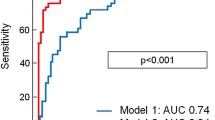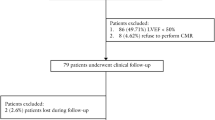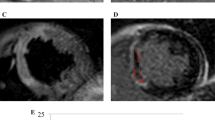Abstract
We sought to determine which contrast-enhanced magnetic resonance imaging (CE-MRI) parameter is the best predictor for left ventricular (LV) remodeling and clinical outcomes after ST-segment elevation myocardial infarction (STEMI). In 135 patients undergoing primary percutaneous coronary intervention (PCI) for STEMI, CE-MRI was performed at a median of 7 days after PCI. Echocardiography was performed soon after PCI and at a follow-up visit. LV remodeling was defined as an increase in end-diastolic volume index ≥20 % on follow-up echocardiography. Several CE-MRI parameters such as infarct size, transmurality, microvascular obstruction (MVO), and hemorrhagic infarction were tested using a 17-myocardial segment model. Optimal cut-off values were derived from receiver-operating characteristic curve (ROC) analysis. Twenty-eight patients (21 %) demonstrated LV remodeling. Although the addition of transmural necrotic segment count, infarct size, and MVO segment count to clinical models improved the prediction of LV remodeling in multivariable regression analysis, transmural necrotic segment count had better incremental predictive value than other CE-MRI parameters. The aggregate consideration of infarct size (cut-off ≥25 %), transmural necrotic segment count (≥5), and MVO segment count (≥2) yielded better diagnostic performance than each of the individual parameters in ROC analysis (P < 0.01). In Kaplan–Meier curve analysis, patients with transmural necrotic segment counts ≥5 had a higher incidence of major adverse cardiac event than did those without. The transmural necrotic segment count is the most important predictor of LV remodeling and clinical outcomes. The combination of CE-MRI parameters including infarct size, transmural necrotic segment count, and MVO segment count appeared to increase reliability for predicting LV remodeling.


Similar content being viewed by others
References
Bolognese L, Neskovic AN, Parodi G, Cerisano G, Buonamici P, Santoro GM, Antoniucci D (2002) Left ventricular remodeling after primary coronary angioplasty: patterns of left ventricular dilation and long-term prognostic implications. Circulation 106:2351–2357
Ganame J, Messalli G, Dymarkowski S, Rademakers FE, Desmet W, Van de Werf F, Bogaert J (2009) Impact of myocardial haemorrhage on left ventricular function and remodelling in patients with reperfused acute myocardial infarction. Eur Heart J 30:1440–1449
Tarantini G, Cacciavillani L, Corbetti F, Ramondo A, Marra MP, Bacchiega E, Napodano M, Bilato C, Razzolini R, Iliceto S (2005) Duration of ischemia is a major determinant of transmurality and severe microvascular obstruction after primary angioplasty: a study performed with contrast-enhanced magnetic resonance. J Am Coll Cardiol 46:1229–1235
Bogaert J, Kalantzi M, Rademakers FE, Dymarkowski S, Janssens S (2007) Determinants and impact of microvascular obstruction in successfully reperfused ST-segment elevation myocardial infarction. Assessment by magnetic resonance imaging. Eur Radiol 17:2572–2580
Wu E, Ortiz JT, Tejedor P, Lee DC, Bucciarelli-Ducci C, Kansal P, Carr JC, Holly TA, Lloyd-Jones D, Klocke FJ, Bonow RO (2008) Infarct size by contrast enhanced cardiac magnetic resonance is a stronger predictor of outcomes than left ventricular ejection fraction or end-systolic volume index: prospective cohort study. Heart 94:730–736
Lockie T, Nagel E, Redwood S, Plein S (2009) Use of cardiovascular magnetic resonance imaging in acute coronary syndromes. Circulation 119:1671–1681
Nijveldt R, Beek AM, Hirsch A, Stoel MG, Hofman MB, Umans VA, Algra PR, Twisk JW, van Rossum AC (2008) Functional recovery after acute myocardial infarction: comparison between angiography, electrocardiography, and cardiovascular magnetic resonance measures of microvascular injury. J Am Coll Cardiol 52:181–189
Tarantini G, Razzolini R, Cacciavillani L, Bilato C, Sarais C, Corbetti F, Marra MP, Napodano M, Ramondo A, Iliceto S (2006) Influence of transmurality, infarct size, and severe microvascular obstruction on left ventricular remodeling and function after primary coronary angioplasty. Am J Cardiol 98:1033–1040
Beek AM, Nijveldt R, van Rossum AC (2010) Intramyocardial hemorrhage and microvascular obstruction after primary percutaneous coronary intervention. Int J Cardiovasc Imaging 26:49–55
Mather AN, Fairbairn TA, Ball SG, Greenwood JP, Plein S (2011) Reperfusion haemorrhage as determined by cardiovascular MRI is a predictor of adverse left ventricular remodelling and markers of late arrhythmic risk. Heart 97:453–459
Choe YH, Choo KS, Jeon ES, Gwon HC, Choi JH, Park JE (2008) Comparison of MDCT and MRI in the detection and sizing of acute and chronic myocardial infarcts. Eur J Radiol 66:292–299
Song YB, Hahn JY, Gwon HC, Kim JH, Lee SY, Choe YH, Choi S-H, Choi J-H, Lee SH (2009) Upstream high-dose Tirofiban does not reduce myocardial infarct size in patients undergoing primary percutaneous coronary intervention: a magnetic resonance imaging pilot study. Clin Cardiol 32:321–326
Cerqueira MD, Weissman NJ, Dilsizian V, Jacobs AK, Kaul S, Laskey WK, Pennell DJ, Rumberger JA, Ryan T, Verani MS (2002) Standardized myocardial segmentation and nomenclature for tomographic imaging of the heart: a statement for healthcare professionals from the cardiac imaging committee of the council on clinical cardiology of the American heart association. Circulation 105:539–542
Schiller NB, Shah PM, Crawford M, DeMaria A, Devereux R, Feigenbaum H, Gutgesell H, Reichek N, Sahn D, Schnittger I et al (1989) Recommendations for quantitation of the left ventricle by two-dimensional echocardiography. American society of echocardiography committee on standards, subcommittee on quantitation of two-dimensional echocardiograms. J Am Soc Echocardiogr 2:358–367
Hombach V, Grebe O, Merkle N, Waldenmaier S, Hoher M, Kochs M, Wohrle J, Kestler HA (2005) Sequelae of acute myocardial infarction regarding cardiac structure and function and their prognostic significance as assessed by magnetic resonance imaging. Eur Heart J 26:549–557
Stephan C, Wesseling S, Schink T, Jung K (2003) Comparison of eight computer programs for receiver-operating characteristic analysis. Clin Chem 49:433–439
Rizzello V, Poldermans D, Boersma E, Biagini E, Schinkel AF, Krenning B, Elhendy A, Vourvouri EC, Sozzi FB, Maat A, Crea F, Roelandt JR, Bax JJ (2004) Opposite patterns of left ventricular remodeling after coronary revascularization in patients with ischemic cardiomyopathy: role of myocardial viability. Circulation 110:2383–2388
Acknowledgments
This work was supported by a grant from the IN-SUNG Foundation for Medical Research, Republic of Korea (grant number: CA88331).
Conflict of interest
None.
Author information
Authors and Affiliations
Corresponding author
Rights and permissions
About this article
Cite this article
Ahn, K.T., Song, Y.B., Choe, Y.H. et al. Impact of transmural necrosis on left ventricular remodeling and clinical outcomes in patients undergoing primary percutaneous coronary intervention for ST-segment elevation myocardial infarction. Int J Cardiovasc Imaging 29, 835–842 (2013). https://doi.org/10.1007/s10554-012-0155-9
Received:
Accepted:
Published:
Issue Date:
DOI: https://doi.org/10.1007/s10554-012-0155-9




